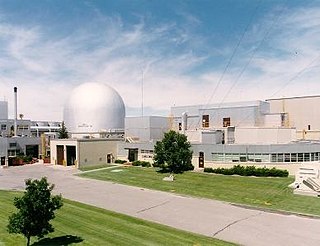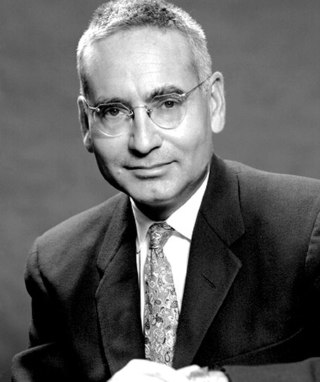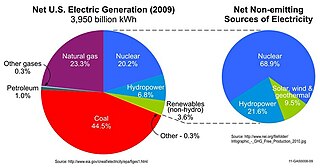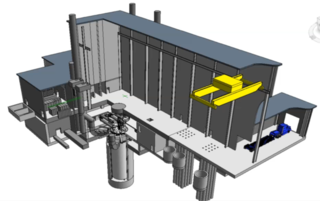
Oak Ridge National Laboratory (ORNL) is a federally funded research and development center in Oak Ridge, Tennessee, United States. Founded in 1943, the laboratory is now sponsored by the United States Department of Energy and administered by UT–Battelle, LLC.

The United States Department of Energy (DOE) is an executive department of the U.S. federal government that oversees U.S. national energy policy and energy production, the research and development of nuclear power, the military's nuclear weapons program, nuclear reactor production for the United States Navy, energy-related research, and energy conservation.

The United States Department of Energy National Laboratories and Technology Centers is a system of laboratories overseen by the United States Department of Energy (DOE) for scientific and technological research. The primary mission of the DOE national laboratories is to conduct research and development (R&D) addressing national priorities: energy and climate, the environment, national security, and health. Sixteen of the seventeen DOE national laboratories are federally funded research and development centers administered, managed, operated and staffed by private-sector organizations under management and operating (M&O) contracts with the DOE. The National Laboratory system was established in the wake of World War II, during which the United States had quickly set-up and pursued advanced scientific research in the sprawling Manhattan Project.

Idaho National Laboratory (INL) is one of the national laboratories of the United States Department of Energy and is managed by the Battelle Energy Alliance. Historically, the lab has been involved with nuclear research, although the laboratory does other research as well. Much of current knowledge about how nuclear reactors behave and misbehave was discovered at what is now Idaho National Laboratory. John Grossenbacher, former INL director, said, "The history of nuclear energy for peaceful application has principally been written in Idaho".

The light-water reactor (LWR) is a type of thermal-neutron reactor that uses normal water, as opposed to heavy water, as both its coolant and neutron moderator; furthermore a solid form of fissile elements is used as fuel. Thermal-neutron reactors are the most common type of nuclear reactor, and light-water reactors are the most common type of thermal-neutron reactor.

The integral fast reactor is a design for a nuclear reactor using fast neutrons and no neutron moderator. IFR would breed more fuel and is distinguished by a nuclear fuel cycle that uses reprocessing via electrorefining at the reactor site.

A molten salt reactor (MSR) is a class of nuclear fission reactor in which the primary nuclear reactor coolant and/or the fuel is a mixture of molten salt with a fissionable material.

The Aircraft Reactor Experiment (ARE) was an experimental nuclear reactor designed to test the feasibility of fluid-fuel, high-temperature, high-power-density reactors for the propulsion of supersonic aircraft. It operated between November 8-12, 1954 at the Oak Ridge National Laboratory (ORNL) with a maximum sustained power of 2.5 megawatts (MW), and generated a total of 96 MW-hours of energy.
Generation IVreactors are nuclear reactor design technologies that are envisioned as successors of generation III reactors. The Generation IV International Forum (GIF) – an international organization that coordinates the development of generation IV reactors – specifically selected six reactor technologies as candidates for generation IV reactors. The designs target improved safety, sustainability, efficiency, and cost. The World Nuclear Association in 2015 suggested that some might enter commercial operation before 2030.

The High Flux Isotope Reactor (HFIR) is a nuclear research reactor at Oak Ridge National Laboratory (ORNL) in Oak Ridge, Tennessee, United States. Operating at 85 MW, HFIR is one of the highest flux reactor-based sources of neutrons for condensed matter physics research in the United States, and it has one of the highest steady-state neutron fluxes of any research reactor in the world. The thermal and cold neutrons produced by HFIR are used to study physics, chemistry, materials science, engineering, and biology. The intense neutron flux, constant power density, and constant-length fuel cycles are used by more than 500 researchers each year for neutron scattering research into the fundamental properties of condensed matter. HFIR has about 600 users each year for both scattering and in-core research.

The Aircraft Nuclear Propulsion (ANP) program and the preceding Nuclear Energy for the Propulsion of Aircraft (NEPA) project worked to develop a nuclear propulsion system for aircraft. The United States Army Air Forces initiated Project NEPA on May 28, 1946. NEPA operated until May 1951, when the project was transferred to the joint Atomic Energy Commission (AEC)/USAF ANP. The USAF pursued two different systems for nuclear-powered jet engines, the Direct Air Cycle concept, which was developed by General Electric, and Indirect Air Cycle, which was assigned to Pratt & Whitney. The program was intended to develop and test the Convair X-6, but was canceled in 1961 before that aircraft was built. The total cost of the program from 1946 to 1961 was about $1 billion.

Alvin Martin Weinberg was an American nuclear physicist who was the administrator of Oak Ridge National Laboratory (ORNL) during and after the Manhattan Project. He came to Oak Ridge, Tennessee, in 1945 and remained there until his death in 2006. He was the first to use the term "Faustian bargain" to describe nuclear energy.

The liquid fluoride thorium reactor is a type of molten salt reactor. LFTRs use the thorium fuel cycle with a fluoride-based molten (liquid) salt for fuel. In a typical design, the liquid is pumped between a critical core and an external heat exchanger where the heat is transferred to a nonradioactive secondary salt. The secondary salt then transfers its heat to a steam turbine or closed-cycle gas turbine.
The National Center for Computational Sciences (NCCS) is a United States Department of Energy (DOE) Leadership Computing Facility that houses the Oak Ridge Leadership Computing Facility (OLCF), a DOE Office of Science User Facility charged with helping researchers solve challenging scientific problems of global interest with a combination of leading high-performance computing (HPC) resources and international expertise in scientific computing.

The Light Water Reactor Sustainability Program is a U.S. government research and development program. It is directed by the United States Department of Energy and is aimed at performing research and compiling data necessary to qualify for licenses to extend the life of America's current 104 electricity generating nuclear power plants beyond 60 years of life. Practically all of the commercial electric-generating nuclear power plants currently in the United States are light water reactor (LWR) plants, meaning they use ordinary (light) water as a moderator and coolant simultaneously.
Alvin William Trivelpiece was an American physicist whose varied career included positions as director of the Office of Energy Research of the U.S. Department of Energy (DOE), executive officer of the American Association for the Advancement of Science (AAAS), and director of Oak Ridge National Laboratory (ORNL). He was also a professor of physics and a corporate executive. Trivelpiece's research focused on plasma physics, controlled thermonuclear research, and particle accelerators. He received several patents for accelerators and microwave devices. He died in Rancho Santa Margarita, California in August 2022 at the age of 91.

The Office of Nuclear Energy (NE) is an agency of the United States Department of Energy which promotes nuclear power as a resource capable of meeting the energy, environmental, and national security needs of the United States by resolving technical and regulatory barriers through research, development, and demonstration.

Titan or OLCF-3 was a supercomputer built by Cray at Oak Ridge National Laboratory for use in a variety of science projects. Titan was an upgrade of Jaguar, a previous supercomputer at Oak Ridge, that uses graphics processing units (GPUs) in addition to conventional central processing units (CPUs). Titan was the first such hybrid to perform over 10 petaFLOPS. The upgrade began in October 2011, commenced stability testing in October 2012 and it became available to researchers in early 2013. The initial cost of the upgrade was US$60 million, funded primarily by the United States Department of Energy.

RELAP5-3D is a simulation tool that allows users to model the coupled behavior of the reactor coolant system and the core for various operational transients and postulated accidents that might occur in a nuclear reactor. RELAP5-3D can be used for reactor safety analysis, reactor design, simulator training of operators, and as an educational tool by universities. RELAP5-3D was developed at Idaho National Laboratory to address the pressing need for reactor safety analysis and continues to be developed through the United States Department of Energy and the International RELAP5 Users Group (IRUG) with over $3 million invested annually. The code is distributed through INL's Technology Deployment Office and is licensed to numerous universities, governments, and corporations worldwide.

The Versatile Test Reactor (VTR) was a project by the U.S. Department of Energy to build a fast-neutron test reactor by 2026. Funding for the project was scrapped in 2022


















